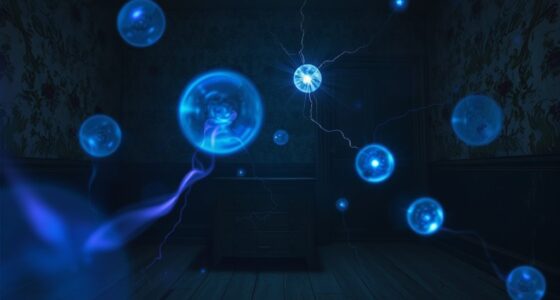Near-death experiences suggest that consciousness might persist beyond death, challenging what science traditionally says about dying. Many report vivid sensations like floatation, lights, and peace, which some believe point to a quantum level of reality where consciousness could transfer or survive physical death. While neurochemistry and brain activity may play roles, quantum theories propose that our awareness might be connected to a universal field. To explore how these ideas could revolutionize our understanding of death, keep exploring further.
Key Takeaways
- Scientific research explores neurochemical and quantum explanations for the vivid sensations experienced during NDEs.
- Quantum consciousness theories suggest NDEs may reveal glimpses into a universal, non-physical reality beyond death.
- Some studies propose consciousness can transfer or persist through quantum entanglement, challenging materialist views.
- Reports of moving into other dimensions or meeting loved ones support the idea of consciousness existing independently of the brain.
- Overall, science investigates NDEs as potential evidence of an afterlife or consciousness enduring beyond physical death.

Near-death experiences (NDEs) are extraordinary events reported by people who come very close to death or temporarily stop breathing. During these moments, many describe vivid sensations—floating above their bodies, seeing brilliant lights, or feeling a profound sense of peace. Scientists have long debated what causes these experiences, and some now explore the intriguing idea of quantum consciousness as a possible explanation. This theory suggests that consciousness isn’t confined solely to the brain but may be connected to a deeper, quantum level of reality. If true, it could mean that consciousness isn’t entirely lost when the brain ceases functioning; instead, it might transfer or persist beyond physical death.
Near-death experiences may hint at consciousness transcending physical death through quantum connections.
Quantum consciousness introduces the concept of consciousness transfer—a process where mental states or awareness can shift from one form to another, possibly outside the boundaries of the physical body. During an NDE, this transfer might manifest as a glimpse into an existence that transcends earthly limitations. Quantum physics hints that particles can be entangled across vast distances, and some researchers propose that consciousness operates on a similar principle. In this view, what you experience during an NDE could be your consciousness temporarily connecting to a universal quantum field, providing a sense of continuity and connection beyond the physical. This isn’t just speculation; some scientists believe that the strange, often inexplicable phenomena observed in NDEs reflect underlying quantum processes. Additionally, recent studies in neuroscience suggest that neurochemical changes in the brain could also contribute to the vividness of these experiences, adding complexity to the debate. Interestingly, the interplay between chemistry and physics may influence how these vivid sensations are generated during such events. Furthermore, ongoing research into quantum biology explores how quantum effects might play a role in biological systems, including the human brain.
If consciousness transfer is real, it could reshape how we understand death itself. Instead of a definitive end, death might mark a transition, a phase where consciousness shifts into a different state or realm. The idea aligns with reports of people feeling they’ve moved into a different dimension or encountered loved ones who have passed away. These experiences could be glimpses of a quantum consciousness that exists independently of the physical brain. It’s as if the mind has the ability to transcend its biological confines, tapping into something greater—an interconnected web of awareness.
While this theory remains controversial and far from universally accepted, it offers a fascinating lens through which to interpret NDEs. It challenges the materialist view that consciousness is merely a product of brain activity. Instead, it suggests that consciousness could be a fundamental aspect of the universe itself, capable of transferring or enduring beyond physical death. Whether or not quantum consciousness is the answer, exploring these ideas pushes science to consider the profound mysteries of life, death, and what might lie beyond.
Frequently Asked Questions
Can Near-Death Experiences Be Scientifically Proven as Evidence of the Afterlife?
You wonder if near-death experiences can be scientifically proven as evidence of the afterlife. While medical documentation shows consistent reports, scientific proof remains elusive. Researchers explore quantum consciousness to explain these phenomena, but definitive proof is lacking. You should consider that current science cannot fully validate NDEs as proof of an afterlife, though they continue to intrigue and inspire ongoing investigation into consciousness’s nature.
Do All Cultures Report Similar Near-Death Experiences?
Think of near-death experiences as a universal language, but with distinct dialects across cultures. While many report similar patterns like tunnels or lights, cultural variations color these stories uniquely. You’ll find common threads, yet each culture adds its own hue, revealing both shared human curiosity and diverse spiritual beliefs. This blend highlights how near-death experiences exhibit universal patterns, yet are shaped by the cultural lens through which individuals interpret them.
How Do Researchers Differentiate Between True NDES and Hallucinations?
When researchers differentiate true NDEs from hallucinations, they examine neural correlates and subjective interpretation. You should know that true NDEs often show specific brain activity patterns, like heightened gamma waves, distinct from hallucinations caused by drugs or brain damage. Researchers also consider the individual’s subjective interpretation, such as feelings of peace or transcendence, which helps distinguish genuine NDEs from mere hallucinations.
What Neurological Processes Are Associated With Near-Death Experiences?
When exploring what neurological processes are linked to near-death experiences, you find that researchers focus on neural correlates and brain activity. During NDEs, specific regions like the temporal lobe and the limbic system become active, producing vivid sensations and emotions. These neural patterns suggest that altered brain activity, especially during extreme stress or oxygen deprivation, plays a significant role in creating the profound experiences reported by individuals.
Are There Long-Term Psychological Effects After Experiencing an NDE?
Imagine emerging from a luminous tunnel, forever changed. You might experience post NDE trauma, feeling overwhelmed or disconnected. Many find themselves on a spiritual journey, seeking integration of their profound experience. These long-term psychological effects vary; some feel renewed purpose, while others grapple with anxiety or depression. Your mind and soul adapt uniquely, but with support, you can find clarity and peace after such an extraordinary event.
Conclusion
As you explore near-death experiences, remember they’re like glimpses through a cracked door — revealing mysteries without fully opening. Just like the woman who felt herself rising above her body, yet couldn’t quite step into the afterlife, these stories remind us that science is still searching for the full picture. While we may not have all the answers yet, each story is a thread pulling us closer to understanding what lies beyond.









